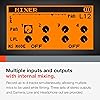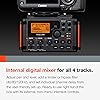TASCAM 4-Channel Portable Audio Recorder for Videographers, 2 Combo XLR/TRS", Dual 3.5mm Inputs, Limiter, HP Filter (DR-60DmkII)











Buy Now, Pay Later
- – 6-month term
- – No impact on credit
- – Instant approval decision
- – Secure and straightforward checkout
Ready to go? Add this product to your cart and select a plan during checkout.
Payment plans are offered through our trusted finance partners Klarna, Affirm, Afterpay, Apple Pay, and PayTomorrow. No-credit-needed leasing options through Acima may also be available at checkout.
Learn more about financing & leasing here.
Selected Option
30-day refund/replacement
To qualify for a full refund, items must be returned in their original, unused condition. If an item is returned in a used, damaged, or materially different state, you may be granted a partial refund.
To initiate a return, please visit our Returns Center.
View our full returns policy here.
style: DSLR Recorder
Features
- Fits perfectly under a DSLR camera rig, without relying on bulky recorders or the limits of the cameras microphone in
- Record up to 4 channels at a time to the internal SD Card, at up to 96kHz/24-bit WAV file resolution
- Two mic inputs utilize locking XLR connectors with 48V phantom power; the other two use a 1/8 stereo connector for wireless and lav mics
- The channel 3/4 input connector supports a high-level maximum input up to +10dBV
- The upgraded HDDA preamps provide up to 64dB of gain and some of the lowest noise levels available
Description
The Tascam DR-60DmkII 4-Channel Portable Recorder for DSLR is the new audio recording solution for on-set filmmakers and videographers using DSLRs. For years, filmmakers have been trying different methods for recording audio - including the use of bulky recorders designed for music and trying to transform the inferior audio technology built-into DSLRs. Now TASCAM has designed an answer that pros and amateurs alike have been waiting for. The DR-60D is a brand new 4-track solid-state recorder utilizing TASCAMs decades of experience. The recorder utilizes high-grade HDDA pre-amps, legendary AD converters, and a durable but lightweight structure and shape. This device will fit snuggly under any camera or into any rig, and record up to 96kHz/24-bit high quality audio straight to SD/SDHC media. Filmmakers have at their disposal two 1/4"-XLR Locking Combo MIC/LINE Inputs, 3.5mm Stereo MIC Input, Camera In, Camera Out, Line Out and Headphone Out. Both 1/4"-XLR Combo Inputs supply +48V Phantom Power and the 3.5mm Input supplies Plug-In Power for microphones requiring a bias voltage. The DR-60D is incredibly easy to use, employing TASCAMs very popular user interface and external controls for every major operation. The body structure, soft-touch keys and dials are designed specifically to help eliminate handling noise. The multiple record modes include, 4-Channel Record, Auto Record and TASCAMs Dual Record "Safety Track" Mode make the DR-60D one of the most versatile recorders on the market. Quality mic preamps are a necessity for quality sound. The DR-60DmkIIs HDDA mic preamplifiers (High Definition Discrete Architecture) employ discrete circuitry and parts, approved after months of evaluation testing by Tascam. The HDDA s circuit achieves a high equivalent input noise (EIN) of -120 dBu for low input noise. The DR-60DmkII mic preamps have been u.pgraded from their predecessor for up to 64 dB of gain with XLR input jacks for greater cable comp.
Compatible Devices: MP3 Player
Brand: Tascam
Hardware Interface: SDHC, Secure Digital Card
Microphone Form Factor: Built-In
Format: WAV
Headphones Jack: 3.5 millimeters
Number of Batteries: 4 AA batteries required.
Memory Storage Capacity: 64 MB
Item Weight: 1.12 Pounds
Screen Size: 1.75
Item Weight: 1.12 pounds
Product Dimensions: 3.07 x 5.24 x 3.67 inches
Item model number: DR-60DMK2
Batteries: 4 AA batteries required.
Is Discontinued By Manufacturer: No
Date First Available: September 15, 2014
Color Name: Black
Compatible Devices: MP3 Player
Hardware Interface: SDHC, Secure Digital Card
Size: 3.67 x 5.24 x 3.07 inches
Battery type: Alkaline
Media Format: WAV
Standing screen display size: 1.75
Frequently asked questions
To initiate a return, please visit our Returns Center.
View our full returns policy here.
- Klarna Financing
- Affirm Pay in 4
- Affirm Financing
- Afterpay Financing
- PayTomorrow Financing
- Financing through Apple Pay
Learn more about financing & leasing here.
























